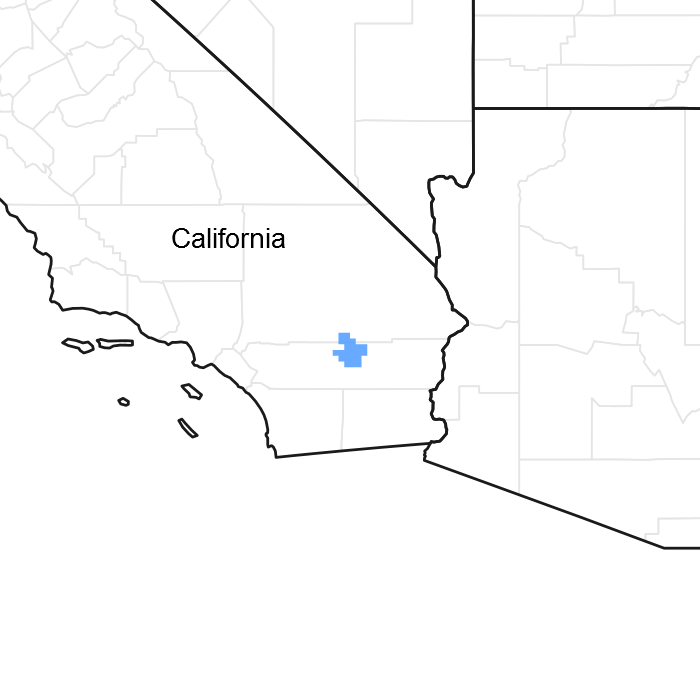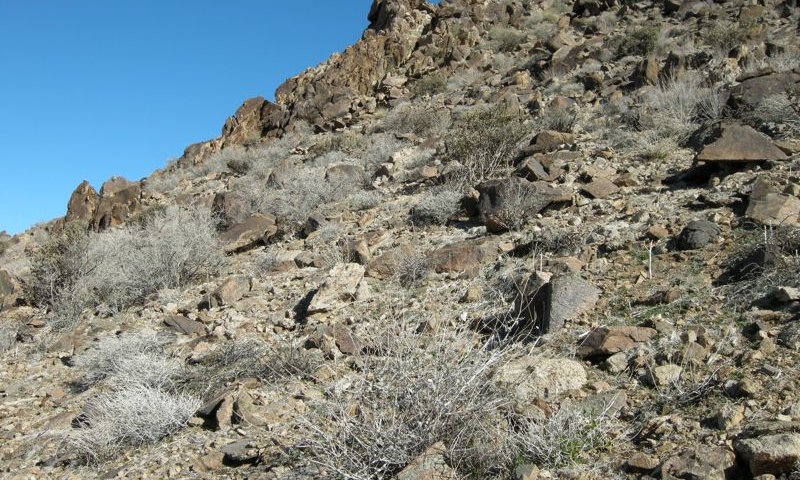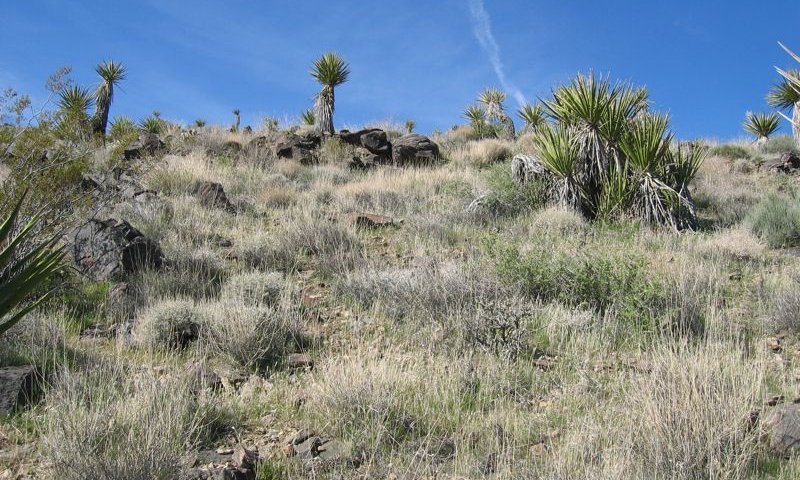

Natural Resources
Conservation Service
Ecological site R030XB193CA
Very Shallow To Moderately Deep Gravelly Slopes
Accessed: 12/22/2024
General information
Provisional. A provisional ecological site description has undergone quality control and quality assurance review. It contains a working state and transition model and enough information to identify the ecological site.

Figure 1. Mapped extent
Areas shown in blue indicate the maximum mapped extent of this ecological site. Other ecological sites likely occur within the highlighted areas. It is also possible for this ecological site to occur outside of highlighted areas if detailed soil survey has not been completed or recently updated.
MLRA notes
Major Land Resource Area (MLRA): 030X–Mojave Basin and Range
MLRA Description:
Major Land Resource Area (MLRA) 30, Mojave Desert, is found in southern California, southern Nevada, the extreme southwest corner of Utah and northwestern Arizona within the Basin and Range Province of the Intermontane Plateaus. The climate of the area is hot (primarily hyperthermic and thermic; however at higher elevations, generally above 5000 feet, mesic, cryic and frigid) and dry (aridic). Elevations range from below sea level to over 12,000 feet in the higher mountain areas found within the MLRA. Due to the extreme elevational range found within this MLRA, Land Resource Units (LRUs) were designated to group the MLRA into similar land units.
LRU Description:
This LRU (designated by ’XB’) is found across the eastern half of California, much of the mid-elevations of Nevada, the southernmost portions of western Utah, and the mid-elevations of northwestern Arizona. Elevations range from 1800 to 5000 feet and precipitation ranges from 4 to 9 inches per year, but is generally between 5-6 inches. This LRU is characterized primarily by the summer precipitation it receives, ranging from 18 – 35% but averages 25%. Summer precipitation falls between July and September in the form of rain, and winter precipitation falls starting in November and ends between February and March, also mostly in the form of rain; however it does receive between 0 and 3 inches of snow, with an average of 1 inch. The soil temperature regime is thermic and the soil moisture regime is typic-aridic. Vegetation includes creosote bush, burrobush, Nevada jointfir, ratany, Mojave yucca, Joshua tree, chollas, cactus, big galleta grass and several other warm season grasses. At the upper portions of the LRU, plant production and diversity are greater and blackbrush is a common dominant shrub.
Ecological Site Concept -
This site occurs on steep mountain slopes at elevations of 2300 to 4820 feet. Soils are very shallow to moderately deep to weathered gneissic or granitoid-dominant bedrock, have a thermic temperature regime, and typically have an argillic horizon within 5 inches of the soil surface.
Production reference value (RV) is 300 pounds per acre and ranges from 160 to 730 pounds per acre with variability due to precipitation-dependent production of annuals. It is characterized by a diverse shrub assemblage comprised of burrobush (Ambrosia dumosa), Parish’s goldeneye (Viguiera parishii), Nevada jointfir (Ephedra nevadensis), jojoba (Simmondsia chinensis) and waterjacket (Lycium andersonii), with a lack of dominance by any one species.
Data ranges in the physiographic data, climate data, water features, and soil data sections of this Ecological Site Description are based on major components only (15 percent of map unit or greater).
Classification relationships
The Ephedra nevadensis Shrubland Alliance (Sawyer et al. 2009) is found within this ecological site.
The Lycium andersonii - Simmondsia chinensis - Pleuraphis rigida Association of the Lycium andersonii Shrubland Alliance (Sawyer et al. 2009) is found within this ecological site.
The Viguiera parishii Shrubland Alliance (Sawyer et al. 2009) is found within this ecological site.
Associated sites
| R030XB005NV |
Arid Active Alluvial Fans R030XB005NV occurs on adjacent fan remnants. Creosote bush (Larrea tridentata) and burrobush (Ambrosia dumosa) dominate. |
|---|---|
| R030XB140CA |
Shallow Hill 4-6" P.Z. R030XB140CA occurs on adjacent slopes. Burrobush (Ambrosia dumosa) and creosote bush (Larrea tridentata) dominate. |
| R030XB164CA |
Steep South Slopes R030XB164CAis found on adjacent slopes. Brittlebush (Encelia farinosa) dominates. |
| R030XB166CA |
Dissected Pediment, Cool R030XB166CA occurs on adjacent pediments at the base of slopes. Blackbrush (Coleogyne ramosissima) and California juniper (Juniperus californica) dominate. |
| R030XB170CA |
Bouldery Very Shallow To Shallow Gravelly Slopes R030XB170CA occurs on adjacent, higher elevation, cool thermic slopes. Blackbrush (Coleogyne ramosissima), Muller's oak (Quercus cornelius-mulleri), single-leaf pinyon pine (Pinus monophylla) and California juniper (Juniperus californica) dominate. |
| R030XB172CA |
Warm Gravelly Shallow Hills R030XB172CA occurs on adjacent slopes. Creosote bush (Larrea tridentata) and Parish's goldeneye (Viguiera parishii) dominate. |
| R030XB189CA |
Shallow Cool Hills R030XB189CA is found on adjacent slopes with a cool thermic soil temperature regime. Blackbrush (Coleogyne ramosissima) and California juniper (Juniperus californica) dominate. |
| R030XE196CA |
Sandy Xeric-Intergrade Slopes R030XE196CA is found on adjacent slopes aridic bordering on xeric soil moisture regimes. Single-leaf pinyon pine (Pinus monophylla) and California juniper (Juniperus californica) dominate. |
Similar sites
| R030XB164CA |
Steep South Slopes This ecological site occurs on south-facing slopes with soils with warm thermic soil temperature regimes, and is strongly dominated by brittlebush (Encelia farinosa). |
|---|---|
| R030XB140CA |
Shallow Hill 4-6" P.Z. This ecological site is co-dominated by burrobush (Ambrosia dumosa) and creosote bush (Larrea tridentata), and has higher production. |
| R030XB139CA |
Shallow Dry Hill 4-6 P.Z. This ecological site is dominated by creosote bush (Larrea tridentata), and production is lower. |
| R030XB172CA |
Warm Gravelly Shallow Hills This ecological site occurs on slopes with a high percentage of large surface fragments and warm thermic soils. The site is dominated by creosote bush (Larrea tridentata) and Parish's goldeneye (Viguiera parishii). |
Table 1. Dominant plant species
| Tree |
Not specified |
|---|---|
| Shrub |
(1) Ambrosia dumosa |
| Herbaceous |
(1) Pleuraphis rigida |
Click on box and path labels to scroll to the respective text.


